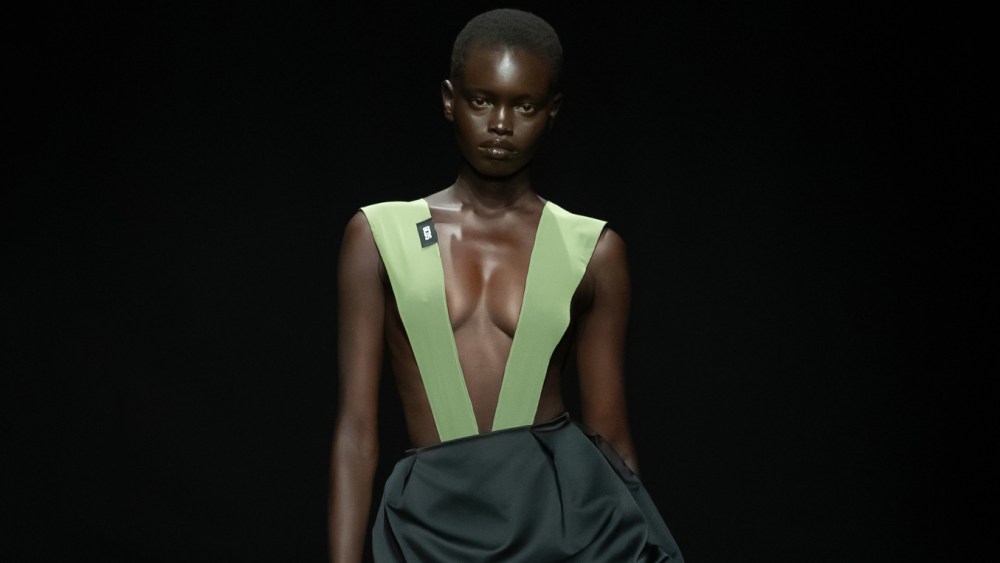“Monse’s rebirthing and expanding itself, thanks to Intel.”
That’s how the fashion company’s co-creative director Fernando Garcia described its latest alliance. He and his co-creative director Laura Kim helped launch the Intel Experience Store in New York with a fashion show Wednesday night. Attendees didn’t just catch see-now-buy-now Monse styles on the runway; an AI-generated video played on the huge screen that served as a backdrop. Located at 1251 Sixth Avenue across the street from Rockefeller Center, the location will be open through Nov. 30.
Meant to highlight how the worlds of art, design and innovation can meld together, the partnership is one that the design duo hopes will continue, and that could also lead to other opportunities in the tech sector. After the show, Garcia, Kim and the luxury company’s chief executive officer Courtney Chow spoke about what’s ahead. Always up for challenging their creative thinking in a new direction, the designers said they are keen to further explore the tech world, which is the field that many Monse customers work in.
For the runway show, the art-centric video was made with AI PCs that were powered by Intel, as a sign of how AI can enhance human creativity. The footage was a compilation of some of the work of the designers’ favorite artists — such as Pablo Picasso, Jean-Michel Basquiat, Caravaggio — which then deconstructed into New York City landscapes, Garcia said. The gathering for the after-work crowd celebrated Monse’s September show, which was held at Uovo, the art and fashion storage facility located in Long Island City. The pair connected with Intel through one of Kim’s friends, who works at Intel. Kim said, “I love working with completely different industries.”
Garcia said, “I love these artists and they reimagined and deconstructed them, which is our DNA [referring to Monse’s design signature.] It was fun to portray our favorite artists through their lens as the backdrop of our show. I simply didn’t know the capacities that these incredible engineers have.”
While the after-work crowd got a closer look of the garments that the designers draped and made themselves on the runway, Intel has helped Monse expand upon what they can articulate through imagery, which helps to explain to the customer what the world of Monse is in a way that is different from what a garment can get to, Garcia said. “It’s a beautiful new tool that we are excited to work with,” he said.
The pair are game for more collaborations in different industries whether that be interiors, hospitality or other areas and new categories. He and Kim expect that the Intel experience will expand their outlook on design, customers and other elements, but they aren’t turning over creative control to AI. Noting how she personally tries on everything that she designs and Garcia paints everything, Kim said, “There is a part that AI can help. But there is that emotional part of my job that I enjoy and that still has to come from us.”
Garcia agreed. “There’s an irreplaceable humanity in anything that a designer contributes to the world that a computer will only make previous references to great work,” he said.
Kim added, “But I’ll definitely take the help so that I can work on more fun stuff.”
Chow, who worked for the investment fund Battery Ventures for six years before joining Monse in July, knows the tech sector well. She said, “In the context of fashion, AI has been helpful in selling clothes. But in luxury fashion, it’s always going to come from a place of taste, point of a view and a connection to beauty, which can be very human. I guess tech can be limitless. But what we do is very emotional and involves building the world around us and what we implemented.”
Fashion and AI have joined forces in different ways. This fall Ralph Lauren debuted an AI-powered shopping tool “Ask Ralph” and Alexander Wang created an AI-generated backdrop for his return to the runway during New York Fashion Week. In March, Viktor & Rolf used an AI narration, a porcelain doll and variations of a singular outfit in their March show, which raised all kinds of questions, including, what is technology’s place in creativity?
Although the pair announced they will be exiting Oscar de la Renta as creative directors, they are still working for the American designer house for a few more months. That said, they are too busy dealing with deadlines to feel that any of their creative energy has been freed up. Garcia said, “We obviously love that family. They helped us to understand our vernacular. We’re excited for us. We’re excited for them.”
But they aren’t planning to offer any input about their successors. “I actually said no. I don’t want to be blamed if somebody doesn’t work out. It’s their decision,” said Kim.
Being part of the board, Garcia ensured that there will be a smooth transition at de la Renta’s namesake company. “It’s such a well-run company. They’re going to be fine,” said Kim.
The separation will be a new starting point for Monse, which is having conversations with potential investors, according to Garcia, who declined to elaborate.
Intel, a $53.1 billion company, has also provided a way for the duo to be exposed to new customers, who are rooted in an area that they don’t know a lot about. Garcia said, “That’s what makes us excited all the time. If you’re not nervous or challenged, you’re not innovating. You’re really not.”
Through the partnership, Intel’s chief marketing officer Brett Hannath said, “We’re showing firsthand how AI technology has the potential to enable better everyday experiences for all of us.”



